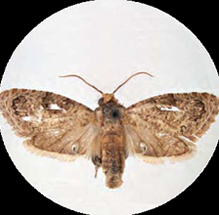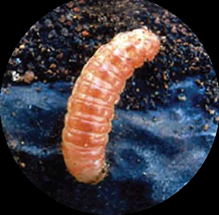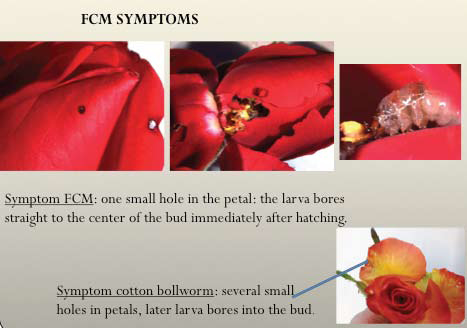
It is the dream of every farmer to export their produce for higher returns. However, many face phytosanitary and technical challenges that lead to rejection of their produce by exporters.
For some time now, Kenya Plant Health Inspectorate Services (Kephis) has been sensitising farmers on what is needed in the export market. James Wahome, General Manager, Phytosanitary Services at Kephis spoke of one pest, False Codling Moth (Thaumatotibia leucotreta) that can stop farmers from exporting their produce.
False codling moth (FCM) hit flowers by close to 10% which led to some interceptions in the market, tainting the image of the country. KEPHIS have urged all growers to adopt more traps to ensure mass trappings of pests which are climate oriented. The players in the industry resolved to involve IPMs manufacturing companies when dealing with specific markets that are sensitive to various pests.
This is a major pest, because the larvae of the moth feeds on a wide range of rose varieties. Lately it is also becoming an issue in in gypsophilla. The brown insect originated from Sub- Saharan Africa, but has also been detected in Europe and US. It thrives under warm and humid conditions and can produce up to five generations annually.
These pests are not only a concern due to economic damage they cause but also giving growers sleepless nights due to the fact that they are of concern to phytosanitary bodies and that detection on shipment will lead to interception hence leading to greater losses. Demand by market to reduce pesticide use of flower leaves growers with limited options for moth control too.
For effective control of these pests, the grower needs to understand their identification and behaviour. When it was first noted in roses, growers gave it different names as they were not sure of the enemy. It is observed to cause damage on the flower bud where the larva enters into the bud leaving behind its frass covering the entry hole on the outside. It then burrows downwards feeding on the inside of the stem hence misleading the observer to call it “stalk borer”. On the cut point it is noted to enter and burrow inside leaving tiny particles of the stem content pilling on top of the cut point, as such the cut point dries up and no new shoots can be realized from such infested points-damaging!
Identification and Management of False Codling Moth (FCM)
False codling moth which bears the scientific name; Thaumatotibia leucotreta and also known as (Citrus codling moth, orange codling moth and orange moth) is a plant pest which attacks many horticultural crops in many parts of the world today. FCM has been listed as the most harmful organism with its many species being listed for quarantine pests.
The pest grows through five stages (Egg- Larva- Pupa-Adult). The most common hosts of FCM are; citrus, avocados, capsicum, corn, sorghum among others, it is estimated that FCM grows in more than 35 species of cultivated plants and more than 48 species of wild plants.
Life Stages
FCM lays small eggs which are invisible to the eyes with a diameter of 1mm and flat oval in shape, they lay eggs on the bud (fruit). FCM normally lay between 5 pm to 11 p.m. The period of hatching ranges between 2 to 22 days. The hatched larvae live for 12 to 65 days depending on the weather conditions. Upon maturity they exit the fruit and drop to the ground on silken threads.
During the larva stage, the pest would attack the crop from where it will bore a hole while feeding and dwelling in it till it pupates where it will gradually spiral down with to the ground. Initially, the female moth lays eggs on the crop surface where they hatch after six days. Once they have hatched they start feeding on the crop. “The female lays eggs where the crop is so as to enable the larvae find food easily.
During its metamorphosis, the FCM larvae bore the crop thus destroying it completely. The larvae are categorized into different instars according to their lengths. According to a crop protection expert, the first four instars are white in colour but this changes to pink with a distinctive black head capsule. The FCM is most destructive at the larval stage.
Pupal stage is dependent on temperature and gender regulation for instance warmer conditions are ideal to a quicker emergence, males mature within 13-48 days and females take 11-40 days.
Identifiction
It is hard to identify the pest during the egg stage because of its invisibility. Once hatched the larvae burrow into the rind of the fruit. A discoloration appears at the point of entrance, while inside they tend to feed on the pulp, causing premature ripening and fruit drop.
FCM in roses are identified from any occurrence of small holes in petals. Once the pest is in larvae stage, it goes straight to the center of the bud
Management and Control The management process of citrus moth (FCM) normally goes through the following processes; Identificationmonitoring- action- evaluation- inspection. To be able to manage pests well, the following management practices should be adhered to; reduction of pests to an acceptable threshold and pest eradication. Acceptable threshold simply means eradication of pests to an economically justifiable number; this is so because continuous application of any preventive measures would be effective from this point. Pest eradication entails complete removal of pests. The most viable strategies to manage pest include; avoidance of pests, early detection and curative measures.
The management process of citrus moth (FCM) normally goes through the following processes; Identificationmonitoring- action- evaluation- inspection. To be able to manage pests well, the following management practices should be adhered to; reduction of pests to an acceptable threshold and pest eradication. Acceptable threshold simply means eradication of pests to an economically justifiable number; this is so because continuous application of any preventive measures would be effective from this point. Pest eradication entails complete removal of pests. The most viable strategies to manage pest include; avoidance of pests, early detection and curative measures.
Managing the pest isn’t easy since they are nocturnal so they can only be detected through trapping using the lures. To monitor the pests, traps are placed about five metres from the growing areas which form the inner buffer zone. However, once the presence of the pest is noted to be too high inside the traps, control through mass trapping or chemical interventions should be applied.
Maintaining high-level of hygiene is also critical in insect and pest management.
All the same, there are other ways in which the FCM pest can still be controlled. One of them is by mating disruption. Unlike in the Mass trapping where you target the males by trapping, here you confuse the males. The strategy here is to use the same substance that mimics the pheromone by smearing it on different locations thus confusing the males. In the end they will not be able to mate.
Equally important is the fact that these methods do not ultimately do away with spraying, rather a farmer should integrate both methods. Trapping the FCM will help you reduce the amount of sprays you use as we have found that it reduces the pests by over 70%.
Once hatched from the eggs, the larvae burrows into the bud. A discolouration appears at the point of entrance. While inside they feed on the pulp.

Eric Ogumo, a crop protection expert, says that over the last two years, the pest incidence has increased due to the changing weather patterns. “Although it has been around, FCM in now classified as an emerging pest because it is affecting exports from Kenya,” he said, adding that the pest has also shifted to rose flowers causing major losses to growers.
Avoidance of Pests
This can be made possible through use of physical barriers like insect proof nets, provision and use of double doors for greenhouse units, paying attention to sanitation and cultural practices which works well for your farm, inspection of seedlings or any other planting materials upon arrival, balanced use of fertilizer, pruning and taking quarantine actions.
Early Detection
Early detection can be achieved when a farm regularly practice scouting and monitoring of its crops to assess and inspect the plants against FCM infestation. Performance of timely scouting and monitoring makes it possible to detect situations where pests are absent or present at ow levels. This method of pests’ management helps the grower to prevent extensive damage of crops and avoidance of unnecessary application thus minimizing expenses in the farm.
Scouting: This identifies the pests, its location and evaluates the extent of damage while analyzing the effectiveness of previous treatments.
Monitoring – This process can be performed through the use of attractants; use of sticky cards and pheromone traps (emits pheromone, which attracts male moths hence get caught in a sticky surface). Monitoring is really vital since FCM lays eggs at different places which makes it difficult to detect, they are also nocturnal, and entry of larvae to the fruit/stem at many stages also makes it difficult to detect thus the need for monitoring. This process gives the advantage against other methods especially when it comes to Moths.
Curative Measures
There are four curative measures namely; biological control, chemical control, insect growth regulators and cultural control.
Biological control
This can be achieved through the use of pathogens, parasitoids, parasites, predators and bio pesticides. These biological control agents are either naturally or commercially available.
Chemical Control
It is important to pay close attention to the right PHI (Pre Harvest Interval) to avoid harvesting crops with chemical residues. It is also ideal to know the Maximum Residue Levels (MRL) recommended and legally allowed by the regulator, consider environment safety, and resistance of pests should be necessary to practicing a good chemical control approach.
It is good to note that chemical control is the most commonly misused pest management strategy especially when it comes to FCM and this has led to pest resistance in most cases. The most common practice with chemical control is use of insecticides with more benefits for instance, less toxic to human and increased pests’ efficacy. The use of systemic insecticides which move through the phloem or xylem can be toxic to phloem feeding insects. Examples of neonicotinoids which translocate through the phloem are; Thiamethoxam, Imidacloprid and Clothianidin. In order to overcome pest resistance the grower should avoid tank mixing, practice pests’ monitoring, avoid the use of persistent chemicals, use chemicals with different modes of actions, practice long term rotation of crops where necessary and using the most effective chemicals at the time of the year.
Insect Growth Regulators
They are less toxic and they kill insects by disrupting their development process. Their complex mode of actions prevents any resistance occurring from the pests. Prevention of insects from entering their reproductive stage blocks any growth and spreading of pests into the plant tissues.
Cultural Control
Whatever cultural practices common in your farm should be exercised consistently. The most common practices are; proper disposal of rejected produce, removal of infested and old flower buds, deep ploughing, removal of alternate hosts, crop rotation, use of trap plants and paying close attention to farm sanitation.
Conclusion
You are advised to identify the most susceptible varieties at the production site, varieties where breeding of the individual hosts occur, use pest management approach which targets at least two developmental stages of FCM, be up to date with what is happening in the surrounding environment. Also refer to the PCPB list of the approved products for FCM.
